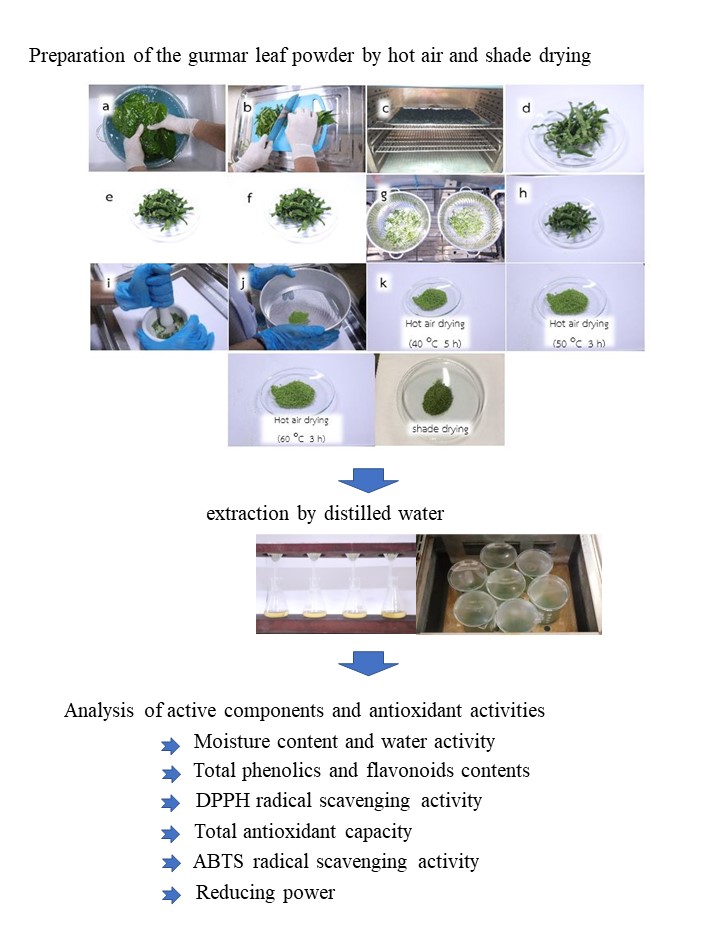Influence of drying methods on total phenolics, total flavonoids and antioxidant activities in the gurmar leaf (Gymnema inodorum (Lour.) Decne.) powder
DOI:
https://doi.org/10.55674/cs.v15i2.247531Keywords:
Gurmar leaves, Drying methods, Phenolics, Flavonoids, Antioxidant activitiesAbstract
The effect of different drying methods on moisture contents, total phenolics, flavonoids and antioxidant activities in the gurmar leaf (Gymnema inodorum (Lour.) Decne.) powder was studied. These drying methods were shade drying and hot air drying at 40 ∞C – 60 ∞C for 3 – 5 h. The percentage of moisture content in powder was 3.15 – 4.83 and the water activities were 0.302 – 0.407. Total phenolics, flavonoids, and antioxidant activities of the extract were analyzed. The powder was extracted by distilled water as extracting solvent with controlled temperature 80 ∞C for 45 min. The results indicated that the hot air-dried powder at 50 °C for 3 h had total phenolics, flavonoids, and antioxidant activities higher than that of the hot air-dried (40 °C for 5 h), hot air-dried (60 °C for 3 h) and shade dried powder, respectively. Total phenolic contents were 20.165, 19.800, 18.115, and 16.903 mg GAE g–1 powder, respectively. Total flavonoid contents were 5.241, 5.238, 5.024, and 4.454 mg CE g–1 powder, respectively. The DPPH free radical scavenging activities were 10.312, 9.684, 9.498, and 8.894 mg AAE g–1 powder, respectively. The ABTS+ radical scavenging activity were 8.929, 8.914, 8.844, and 8.819 mg TE g–1 powder, respectively. Total antioxidant capacities were 42.118, 39.639, 38.812, and 37.040 mg AAE g–1 powder, respectively. The reducing powers were 13.195, 13.110, 11.832, and 11.354 mg AAE g–1 powder, respectively. The drying temperature and time affected on the water-soluble phenolics, flavonoids and antioxidant activities in the water extracts of gurmar leaf powder from different drying methods.
References
P. Yingthongchai, P. Sirikhum, S. Nilsamranchit, S. Tateing, Comparison of Nutritional Value and Bioactive Compounds in Gymnema inodorum Decne. Leaves, J. Agric. 34(3) (2018) 363 – 372.
P. Tiwari, B.N. Mishra, N.S. Sangwan, Phytochemical and Pharmacological Properties of Gymnema sylvestre: An Important Medicinal Plant, Biomed Res Int. (2014) 830285.
V.A. Khramov, A.A. Spasov, M.P. Samokhina, Chemical composition of dry extracts of Gymnema sylvestre leaves, Pharm. Chem. J. 42(1)(2008) 30 – 32.
P. Daisy, J. Eliza, K.A. Mohamed Farook, A novel dihydroxy gymnemic triacetate isolated from Gymnema sylvestre possessing normoglycemic and hypolipidemic activity on STZ-induced diabetic rats, J. Ethnopharmacol. 126 (2009) 339 – 344.
L. Zheng, Y. Zhang, Y. Liu, X.O. Yang, Y. Zhan, Momordicacochinchinensis Spreng. seed extract suppresses breast cancer growth by inducing cell cycle arrest and apoptosis, Mol. Med. Rep. 12 (2015) 6300 – 6310.
S. Shanker, Phytochemical constituents of Dracaena mahatma leaves and their anti-bacterial, anti-oxidant and anti-inflammatory significance, Biotechnol. Res. Innov. 2 (2018) 1 – 8.
S. Kota, An Investigation into phytochemical constituents, antioxidant, antibacterial and anti-cataract activity of Alternanthera sessilis, a predominant wild leafy vegetable of South India, Biocatal. Agric. Biotechnol. 10 (2017) 197 – 203.
M. Zheng, Q. Xia, S. Lu, Study on drying methods and their influences on effective components of loquat flower tea, LWT – Food Sci. Technol. 63 (2015) 14 – 20.
N. Chahmi, J. Anissi, S. Jennan, A. Farah, K. Sendide, M.E. Hassouni, Antioxidant activities and total phenol content of Inula viscosa extracts selected from three regions of Morocco, Asian Pac J Trop Biomed. 5(3) (2015) 228 – 233.
J. Rodriguez, C. Ortuno, J. Benedito, J. Bon, Optimization of the antioxidant capacity of thyme (Thymus vaulgaris L.) extracts: Management of the drying process, Ind Crops Prod. 46 (2013) 258 – 263.
X. Chen, Effects of drying processes on starch-related physicochemical properties, bioactive components and antioxidant properties of yam flours, Food Chem. 224 (2017) 224 – 232.
O.R. Alara, N.H. Abdurahman, S.K. Abdul Mudalip, O.A. Olalere, Effect of drying methods on the free radicals scavenging activity of Vernonia amygdalina growing in Malaysia, JKSUS. 5 (2017) 81 – 86.
A. Wongklom, Effect of different drying methods on the water soluble total phenolics and flavonoids contents, and antioxidant activities of sunchoke (Helianthus tuberosus L.) powder, SNRUJST. 10(3) (2018) 170 – 177.
M. Saifullah, R. McCullum, A. McCluskey, Q. Vuong, Effects of different drying methods on extractable phenolic compounds and antioxidant properties from lemon myrtle dried leaves, Heliyon. 5(12) (2019) e03044.
K.D.R.R. Silva, M.S.F. Sirasa, Antioxidant properties of selected fruit cultivars grown in Sri Lanka, Food Chem. 238 (2016) 203 – 208.
S.C. Liu, J.T. Lin, C.C. Hu, B.Y. Shen, T.Y. Chen, Y.L. Chang, C.H. Shih, D.J. Yang, Phenolic compositions and antioxidant attributes of leaves and stems from three inbred varieties of Lycium Chinense Miller harvested at various times, Food Chem. 215 (2017) 284 – 291.
O.R. Alara, S.K. Abdul Mudalip, O.A. Olalere, Optimization of mangiferin extracted from Phaleria macrocarpa fruits using response surface methodology, J. Appl. Res. Med. Aromat. Plants. 5 (2017) 82 – 87.
V. Marecek, A. Mikyska, D. Hampel, P. Cejka, J. Neuwirthová, A. Malachová, R. Cerkal, ABTS and DPPH methods as a tool for studying antioxidant capacity of spring barley and malt, J. Cereal Sci. 73 (2017) 40 – 45.
Kenneth Helrich, Official method of analysis, 15th, Association of official analytical chemists, Inc., USA, 1990.

Downloads
Published
How to Cite
Issue
Section
Categories
License
Copyright (c) 2023 Creative Science

This work is licensed under a Creative Commons Attribution-NonCommercial-NoDerivatives 4.0 International License.








